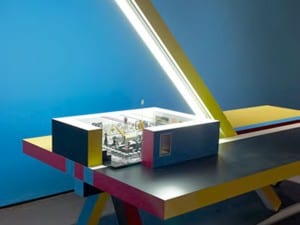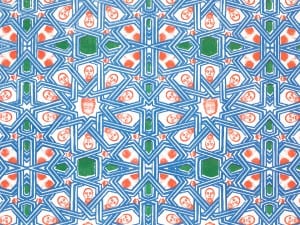Centre Pompidou launches a retrospective of the still influential French designer whose craft, power and pragmatism set his work apart from 1960s pop.
Pierre Paulin (1927-2009) is known for his buoyant, brightly coloured furniture and forms, which look as though they were made by a lava lamp. However, the designs stretch far beyond 1960s kitsch. When Paulin first started experimenting with foam and swimwear material in the late 1950s, he placed an unprecedented emphasis on comfort; lovely as it was to perch on Arne Jacobsen’s Egg or curl up in Eero Aarnio’s Ball Chair, it was nothing like lounging on the Tongue or the Tulip. Paulin’s death in 2009 triggered a series of tribute exhibitions, and the Centre Pompidou is currently staging a 40-year survey. From student drawings to statement designs for the Élysée Palace, the show is a testament to his enduring popularity – but what was it that allowed for Paulin’s work to outlive the 1960s?
For Cloé Pitiot, curator of the exhibition, Paulin’s designs have a paradoxical quality, a combination of poetry and pragmatism. “There was something about him which was not quite of this world,” she says. “He existed on separate plane of form, line and colour.” However, you couldn’t accuse Paulin of being whimsical or utopian. His mantra was strict and straightforward: “I pledge loyalty to functionalism; my abiding concern and prime motivation is comfort in design.” Paulin’s philosophy of applied design was sparked by childhood conversations with his uncle, a highly skilled car designer who taught Paulin how innovation and artistry could be combined. Good design became associated with heroism when his uncle, a prominent gure in the French Resistance, was executed by the Nazis during the war. Paulin committed himself to a pursuit of art through rigorous attention to form and material, stating “I don‘t create. I devise, I design.” Perhaps those are the defining qualities of a good designer; a capacity for idealism, and one foot firmly on the ground. However, Paulin might have continued his original training as an artist and stone carver if he hadn‘t suffered an injury in the late 1940s. Instead, he took that artistic sensibility with him into the eld of design. After studying at the École Camondo in Paris between 1947 and 1950, his first job at Marcel Gascoin’s agency brought him into contact with young French designers who admired the pared-down aesthetic of Japan and Scandinavia. Designers such as Michel Mortier and Pierre Guariche passionately believed in the importance of applied design with a mass market appeal, taking a socially responsible approach in the post-war era.
“In the beginning it was very important for him to learn from the work of other practitioners,” Pitiot explains. “As well as Scandinavian designers like Alvar Aalto he was strongly in uenced by the Americans, especially Charles and Ray Eames, Harry Bertoia and George Nelson – seeing Harry Bertoia’s Diamond Chair and Paulin’s 1958 Tripod you might have thought they were by the same designer.” Paulin’s works are saved from being derivative by their singular concentration on comfort: they are generated by their own intention. “He was very preoccupied with the idea of how people want to live,” Pitiot says. “His designs were made for humans, not the idea of a human.”
Visiting Sweden in the 1950s Paulin decided that his “future would probably lie in designing wooden furniture that would be accessible to all budgets.” His first designs on graduating had been made in plywood, and his practice was informed by his study of the 18th century French cabinet makers, such as André-Charles Boulle, and the “Goût grec” or Neoclassical style favoured by the French court. “His work has elements from all periods,” says Pitiot. “You can nd those forms translated to the 20th century – for instance the Mushroom is a version of the traditional 19th century crapaud or ‘toad’ armchair.” However, to use Paulin’s own words: “as soon as you start using new materials, everything changes.” Toad or no toad, there’s no denying that the Mushroom was unlike anything seen in the Parisian showrooms in 1960.
It was during a stint with the design company Thonet, best known for their development of the bentwood furniture, that Paulin found the resources to move beyond simple wooden forms and invent an entirely new technique. With the company’s support, in the late 1950s he experimented with synthetic foams and fabrics, covering chairs with removable skins made from industrial stretch material. “He saw the body of a woman in swimwear,” explains Pitiot, “and translated the image into a piece of furniture. That’s what makes Paulin’s work so different, the constant dialogue with the body. For me, his designs are like people – you have the form shaped by the skeleton, then the muscle, then the skin.” For Paulin, that affnity with the human form was essential to the design process – it was what brought an object alive.
“To be a designer,” he once wrote, “you need a body alive to sensation, a certain sensitivity. Above all you need to like the human body, for its contours and morphology.”
Impressed by his innovations for Thonet, the Dutch company Artifort took him on a designer; in 1960 his iconic Mushroom chair changed the face of the company and their output over the next 20 years. Moving beyond mix-and-match chair covers, Paulin focused on the morphology of the chair itself: by replacing the legs with a simple wooden disc and concealing the tubular metal frame beneath a foam cladding and fabric skin, he created an ergonomic form which served as the prototype for an evolving series of designs: the origami-like Butterfly of 1963, the inviting Tulip of 1965, the curious “snap shut” shape of Concorde in 1965, the satisfying folds of Ribbon in 1966. “No one had done anything like it in Europe” Pitiot explains. “Essentially, he invented comfort.” At the time, this was revolutionary.
These chairs were experiments in how far Paulin could “push the materials of modernity” – all informed by the quest for comfort, but occasionally thrown o course by the need to radicalise the shape. Arguably, the most effective works were the original Mushroom and the exquisitely simple Langue of 1967 – a singular undulation, somewhere between a langue de chat biscuit and a reclining human figure. For Pitiot, it’s the Déclive (1968), which shows what Paulin was all about. “I love the idea of Paulin creating a sort of ‘flying carpet’,” she says. “Works like this changed the way space was arranged. You could live a whole new style of life down on the oor, up in the air. Sitting on the chair, you become a traveller.”
The Déclive is suspended in motion, ready to curl up or extend outwards – it is the embodiment of Paulin’s exibility as an artist. “You could compare him to a dancer,” Pitiot enthuses. “He could do everything, and I wanted to do everything in the exhibition. In fact, when you enter the show it’s almost as though you’re seeing the work of multiple different designers. First you have the strict lines of the works in wood and metal from the 1950s, then suddenly you see that he also devised lights – we have a rare, spider-like ceiling lamp from 1965 and an unusual candelabra from the 1950s. Then you have the industrial items for ADSA, like plates, steam irons and a coffee machine, and the pieces he constructed for the French government using precious wood and classical lines. I wanted to show Pierre Paulin’s ability to create for everybody – from the mass market to the President of the Republic”, demonstrating his universality.
The same exibility that made his work so appealing was also the source of occasional resentment. When Paulin was commissioned to rethink the interiors of the private apartments of President Pompidou in 1971, he became associated with government approval – later, in the 1980s, he was called in to adjust the spaces to the slightly more spartan taste of President Mitterrand. “Asking Paulin to reshape his private apartments was a way for Pompidou to demonstrate his avant-garde attitude to art and architecture. The same is true of the Centre Pompidou itself – a radical new museum intended for everyone. It was a way of showing that France was a dynamic culture.” Although Paulin’s designs are certainly innovative, you can’t help but see why they were a safe bet for a politician. It’s impossible to be in a bad mood while sitting in a Paulin chair, and his smoking lounge for the Elysée Palace bore more than a passing resemblance to a padded cell. Were Paulin’s designs just too comfortable?
For decades, Paulin’s reputation was dominated by his association with the government. The year before he died, the Galerie des Gobelins presented Le Design Au Pouvoir (Design in Charge), focusing on the designer’s work for the French state. However, since his death there has been a renewed interest in his early work and self-published projects. In May the Galerie Pascale Cuisinier is presenting works made between 1952 and 1959, showing the evolution of ideas, which led to the Mushroom chair in 1960. The Centre Pompidou also pays attention to the last two decades of Paulin’s life, spent in the seclusion of the Cévennes. “In these years he moved back to working with wood. He wanted to work slowly, to touch the material and explore the possibilities known to the cabinet makers. Even that was avant-garde – now we see that attention to wood in the work of the Irish designer Joseph Walsh. Paulin was one of the rst to realise that society needed to slow down.”
As a person, Paulin was intensely cerebral. Pitiot tells of the family movies she watched with Paulin’s wife and children, when he might be seen alone in a chair, silently contemplating. “People say he was a difficult man, hard to talk to sometimes. However, I think he was just in an interior world, a true creator.” His works reveal a greater empathy, best appreciated by sinking into one of his chairs. “Choose the one you want depending on whether you want to dream, or read, or sleep,” Pitiot advises. “The Mushroom is good for tea with friends. The chairs, which are low on the floor, make you feel as though you’re in the sky.”
The exhibition at the Centre Pompidou offers plenty of first-hand experiences for visitors. Watching the short documentary about Paulin is a bit like a game of musical chairs; as they watch, attendees are invited to test out the comfort of the Ribbon, the Orange Slice and the Tulip. There’s even a unique opportunity to nestle in the folds of the sculptural Diwan carpet, providing you take your shoes off beforehand. Overall, you can’t help but feel that Paulin – part poet, part pragmatist – would have approved.
Words Matilda Bathurst
Pierre Paulin. 11 May – 9 August, Centre Pompidou. www.centrepompidou.fr
Pierre Paulin, Première Période: 1952-1959. 14 April – 28 May, Galerie Pascal Cuisiner. www.galeriepascalcuisinier.com





